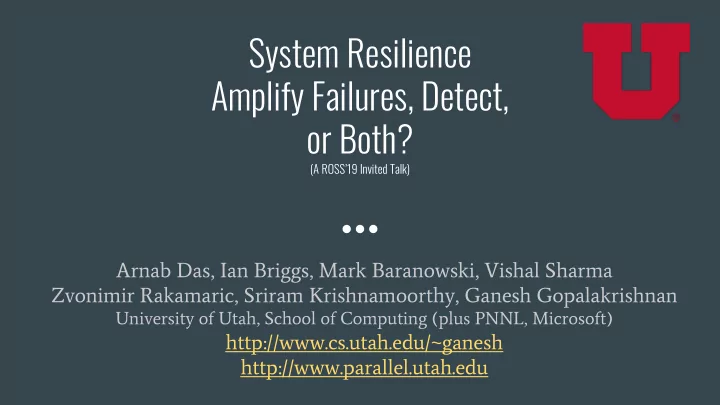

System Resilience Amplify Failures, Detect, or Both? (A ROSS’19 Invited Talk) Arnab Das, Ian Briggs, Mark Baranowski, Vishal Sharma Zvonimir Rakamaric, Sriram Krishnamoorthy, Ganesh Gopalakrishnan University of Utah, School of Computing (plus PNNL, Microsoft) http://www.cs.utah.edu/~ganesh http://www.parallel.utah.edu
System Resilience: Need
System Resilience: Need
System Resilience: Need
System Resilience: Want SELSE 2019
System Resilience: Plausible Reasons for Lack of Adoption No continued investment (in many cases) ● Community unprepared to stomach costs ● New fault models -> accepted! ○ What to do after detection -> accepted! ○ Papers on detection itself often rejected ○ as indicated by rejection (plus the stated reasons) ■ Nobody wants 30% overhead ● “Why not go back to earlier lithography?” ○ Other problems that make it worse: ● Lack of guarantees on detection ○ High false positive rates ○ Unacceptable, given that bit-flips themselves are rare! ■
Path Forward Ultra-low costs ● Ultra-tight guarantees ●
This talk Approach to detect with rigorous guarantees ● Focus on specific domains ○ Stencil codes ■ Offer rigorous guarantees and reasonable overheads ○ Our approach: FPDetect ■ Approach to amplify failures ● To manifest them more ○ Leads to cheaper detection ○ FailAmp ○
This talk Approach to detect with rigorous guarantees ● Focus on specific domains ○ Stencil codes ■ Offer rigorous guarantees and reasonable overheads ○ Our approach: FPDetect ■ Approach to amplify failures ● To manifest them more ○ Leads to cheaper detection ○ Our approach: FailAmp ■
This talk Approach to detect with rigorous guarantees ● Focus on specific domains ○ Stencil codes ■ Offer rigorous guarantees and reasonable overheads ○ Our approach: FPDetect ■ Approach to amplify failures ● To manifest them more ○ Leads to cheaper detection ○ Our approach: FailAmp ■ Capitalize on custom fault models to obtain lower overheads ■ Concluding Remarks: ● How to ensure that the area stays viable? ○
FPDetect Stencil codes are a good target for protection ● Higher computational intensity ○ SDCs can build up ○ based on the nature of the PDEs being solved ■ Problem with putting assertions around data ● Don’t know exact invariants ○ Machine-learned models tried → too imprecise ○ Weaker invariants will trigger false alarms ■ Obvious insight ● There is an ever-present invariant ○ A duplicated computation! ■
FPDetect Doing duplication naively is unwise ● Too much overhead ○ Our (rather unusual) approach ● Find what the value will be T steps later! ○
FPDetect Doing duplication naively is unwise ● Too much overhead ○ Our (rather unusual) approach ● Find what the value will be T steps later! ○
FPDetect Approach (higher level) Find out what the value will be T steps later ● Guarantee b bits of mantissa exactly ● If at runtime we observe b bits not being preserved, then…. ○ Conclude that a bit-flip occurred! ■
FPDetect Approach
FPDetect Optimization Compute per Binade-difference group And have it in a table For lookup
FPDetect Detector Stacking (shows spatial stacking, temporal stacking, and coverage “holes”)
FailAmp “Make a bad problem worse” ● So it can be observed more readily! ○
FailAmp: Make a transient address “blip” permanent
FailAmp protects AGUs (images from Wikipedia below)
FailAmp in a nutshell An LLVM transformation ● Rewrite the Get Element Pointer instructions pertaining to array accesses ○ Flow relativized addresses via new Phi-nodes ○ Put detectors as frugally as possible ○ It is a “whole function relativization” ● Existing compilers often do for one loop ○ They don’t connect-up relativization chains ○
FailAmp rewrites GEP instructions GEPs are “One stop ● shopping” for Arrays of Structs of Arrays Also handles ● vectorization
FailAmp rules, and a generic example
FailAmp Compilation Rule (general case) There are Special cases Where the Generated code Can be simplified
FailAmp Coverage Results
FailAmp highlights Found mistake in initial rules ● Formal verification using SMACK caught mistake ○ Now FailAmp catches 100% of all injected address faults ● Injections done AFTER compiler optimizations (various) ○ This is CRUCIAL to manifest many GEP sequences ○ ARM has single instruction that fuses key FailAmp steps ● Post-indexed addressing ○ Effective Address calculated replaces base address ■ X86 needs 2 instructions (calculate Eff. Addr and load as new base; ARM takes one) ■ Preliminary results on LULESH for FailAmp on a 96 x 96 x 96 cube ● 5% overhead ○ 100% detection of address faults ○ No False Positives! ○
FailAmp Overhead Results
Concluding Remarks We presented FPDetect and FailAMP – two complementary approaches for ● system resilience Both are usable in a context that uses polyhedral optimizations ● ● Measured effective before/after PLUTO transformations FPDetect also helps detect logical bugs ● Would be interesting to develop interesting mixes of amplification + detection ● E.g., even FPDetect + FailAmp makes sense... ○ Cross-layer resilience schemes are essential to curb overheads and localize faults ● Must view resilience as “End of Moore Insurance” ● Tight-rope walk at End of Moore ○ Good detectors catch falls and helps us recover ○
Extra: Intel vs ARM
Extra: Intel vs ARM
Recommend
More recommend